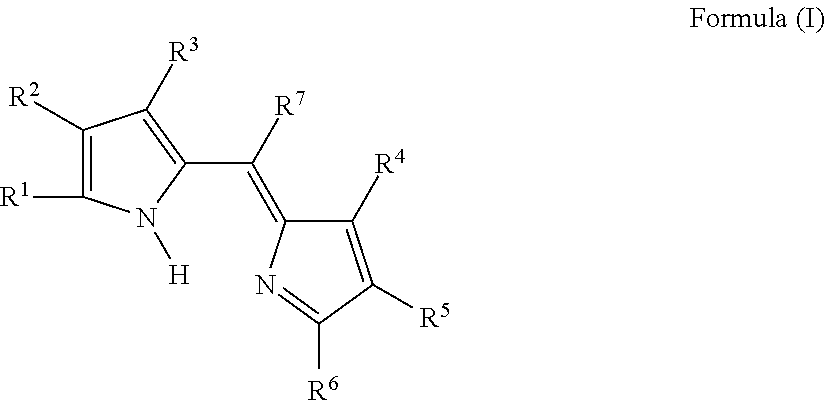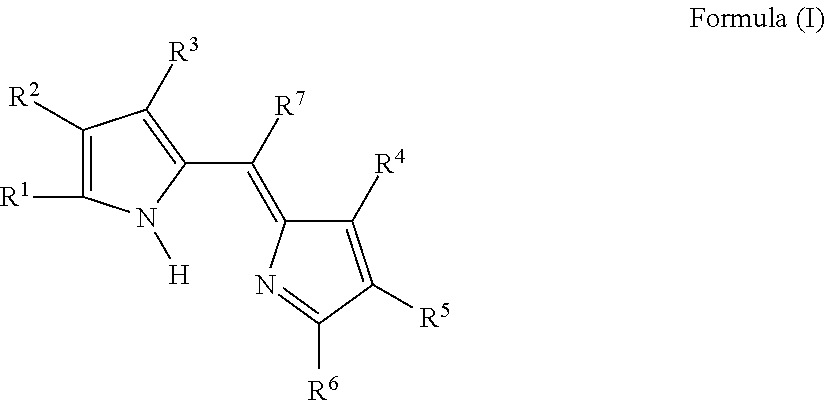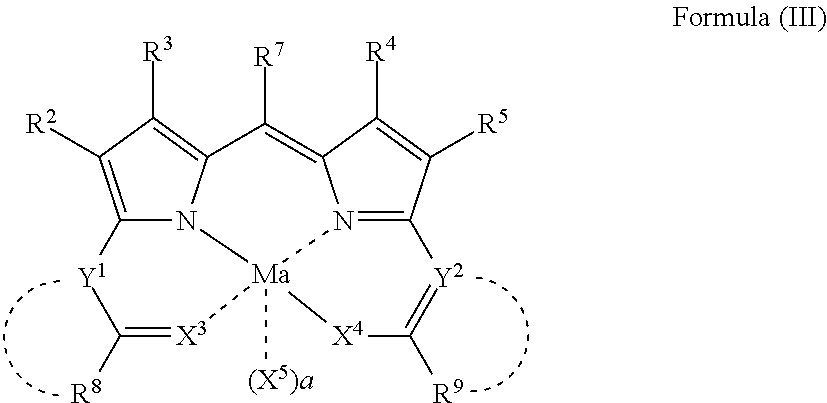Compound or its tautomer, metal complex compound, colored photosensitive curing composition, color filter, and production
a technology of metal complex compound and pigment, applied in the field of compound or its tautomer, metal complex compound, colored photosensitive curing composition, color filter, etc., can solve the problems of dyes generally being less light stability and heat resistance than pigments, and difficulty in further improving resolution
- Summary
- Abstract
- Description
- Claims
- Application Information
AI Technical Summary
Benefits of technology
Problems solved by technology
Method used
Image
Examples
synthesis example
[0191]Hereinafter, methods of synthesizing the colorant represented by the Formula (A) or (B) will be described in detail along the following scheme D, by taking the exemplary compound CI-29 above as an example.
[0192](Synthesis of Intermediate A)
[0193]Sodium carbonate (16.5 g, 0.156 mol) was added to a mixture of 3-nitrophthalonitrile (25 g, 0.144 mol), DMSO (200 ml), and sodium 3-mercaptopropanesulfonate salt (32 g, 0.18 mol), and the mixture was stirred as heated to 60° C. for 3 hours. The reaction mixture was poured into 10% sodium chloride water (300 g), and the precipitated solid was collected by filtration and washed with a mixed liquid of isopropanol / water (3 / 1). Water (200 ml), acetic acid (3 ml) and Na2WO4 (2 g) were added to the solid; 31% hydrogen peroxide solution (50 ml) was added thereto; and the mixture was stirred while heated at 60° C. After stirring fro 4 hours, the reaction mixture was poured into isopropanol (500 ml), and the precipitated solid was collected by f...
example 1
[0312]Intermediates 4, 5, and 11 (compounds represented by Formula (IV)), and exemplary compounds shown below were synthesized along the reaction scheme A to C described above according to the synthesis method described above. The molar absorption coefficient of each synthesized exemplary compound was determined in ethyl acetate solution (by using a spectrophotometer UV-2400PC (manufactured by Shimadzu Corporation)), and the maximum absorption wavelength (λmax) and the molar absorption coefficient (ε) are summarized in the following Table 4. The absorbance (Abs) of each colorant at 450 nm was evaluated, as normalized with respect to 1.0 of the absorbance at the measurement maximum absorption wavelength (λmax). Results are summarized in Table 4.
TABLE 4Abs. at 450 nm,Exemplarynormalized to Abs. =compoundλmaxε1.0 at λmaxIII-1533.11300000.0125III-45546.71283000.0068III-70540.01260000.0068III-80540.01230000.0100II-5514.6807000.1300I-1558.31290000.0096I-2578.31225000.0041I-4540.01190000.0...
example 2
[0314]1) Preparation of Resist Solution
[0315]Propylene glycol monomethylether acetate (PGMEA) 19.20 parts
[0316]Ethyl lactate 36.67 parts
[0317]Binder (benzyl methacrylate / methacrylic acid / 2-hydroxyethyl methacrylate) copolymer (molar ratio: 60:20:20) 41% EL solution 30.51 parts
[0318]Dipentaerythritol hexaacrylate 12.20 parts
[0319]Polymerization inhibitor (p-methoxyphenol) 0.0061 parts
[0320]Fluorochemical surfactant 0.83 parts
[0321]Photopolymerization initiator TAZ-107 (manufactured by Midori Kagaku Co., Ltd.) 0.586 parts
[0322]These components were blended and solubilized, to give a resist solution.
[0323]2) Preparation of Glass Substrate Having an Undercoat Layer
[0324]A glass substrate (Corning 1737) was ultrasonicated in 0.5% aqueous NaOH solution, dehydrated, and baked (200° C. / 20 minutes).
[0325]The resist solution 1) above was then applied on a clean glass substrate to a film thickness of 2.0 μm by a spin coater, and the plate was dried under heat at 220° C. for 1 hour, to give a c...
PUM
| Property | Measurement | Unit |
|---|---|---|
| thickness | aaaaa | aaaaa |
| absorption wavelength | aaaaa | aaaaa |
| absorption wavelength | aaaaa | aaaaa |
Abstract
Description
Claims
Application Information
 Login to View More
Login to View More - R&D
- Intellectual Property
- Life Sciences
- Materials
- Tech Scout
- Unparalleled Data Quality
- Higher Quality Content
- 60% Fewer Hallucinations
Browse by: Latest US Patents, China's latest patents, Technical Efficacy Thesaurus, Application Domain, Technology Topic, Popular Technical Reports.
© 2025 PatSnap. All rights reserved.Legal|Privacy policy|Modern Slavery Act Transparency Statement|Sitemap|About US| Contact US: help@patsnap.com



